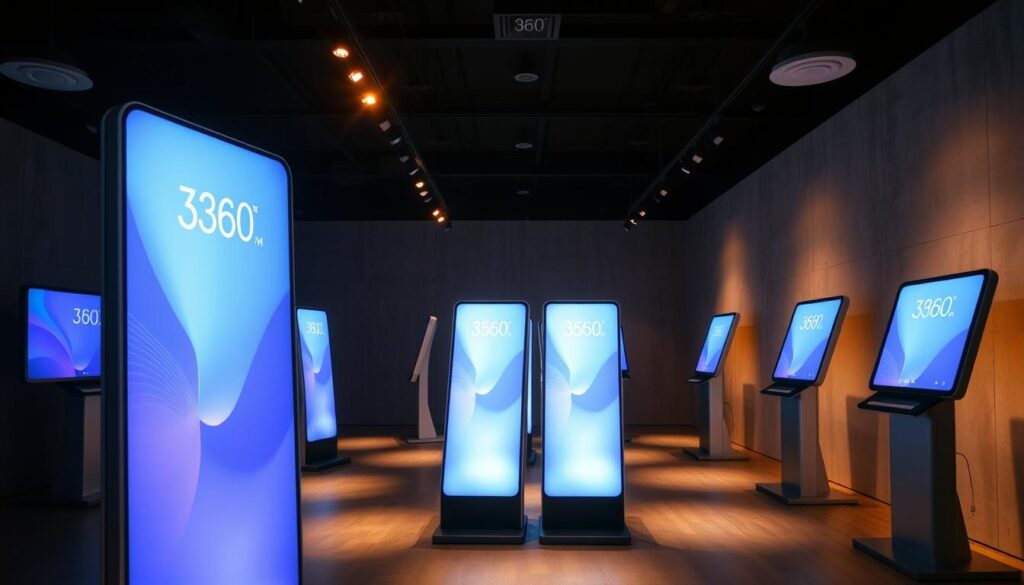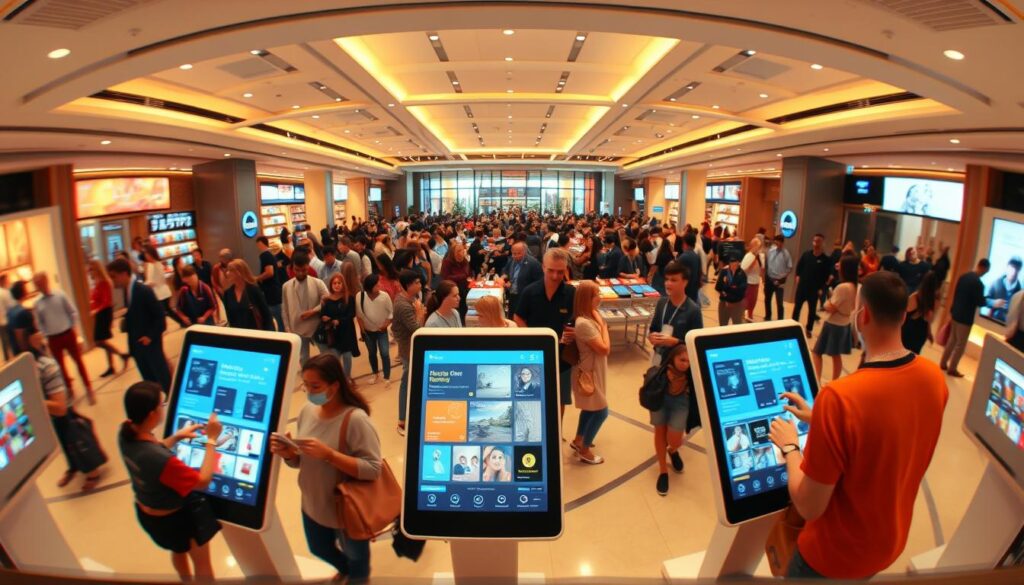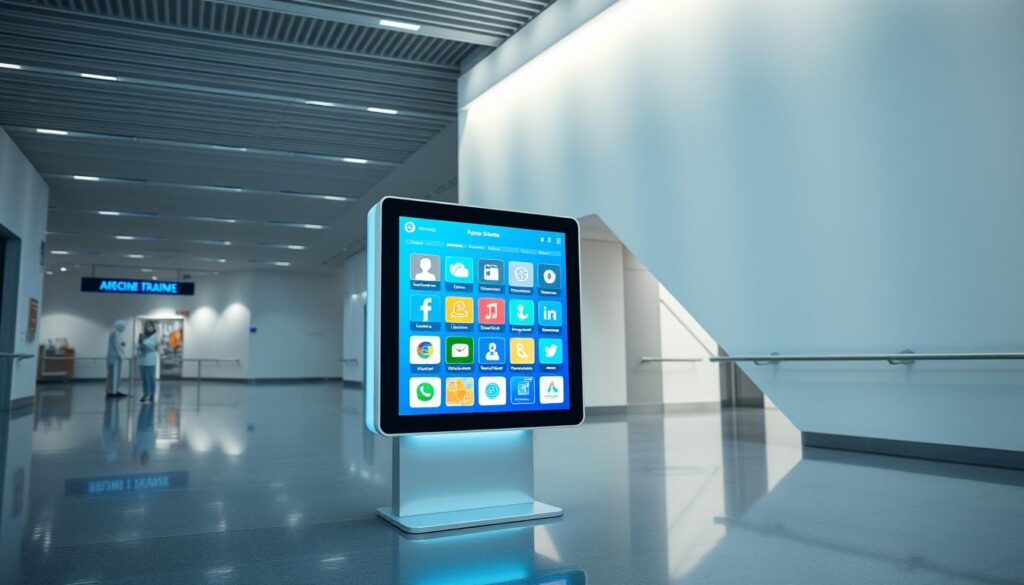360 digital kiosks are changing how we shop by mixing tech with easy-to-use tools. These kiosks let customers look at products, buy things, and get special deals on their own. This makes shopping faster and more fun, unlike old ways.

Studies show these kiosks can increase sales by up to 30% by showing product details. They also make checkout faster by half. Stores using them save on labor and make customers happier, showing their value.
By 2025, more businesses will use these kiosks to get leads and make interactions smoother. They are key for keeping up with today’s customer needs.
360 digital kiosks are more than just tools. They open doors to personal shopping experiences. They work with mobiles, offer easy touchless use, and gather useful data. With AI and secure data handling, they promise both speed and safety in every interaction.
Understanding 360 Digital Kiosks and Their Evolution
Modern interactive kiosks have changed a lot. They are no longer just simple displays. Now, they use advanced technology for a better user experience. Their journey shows a focus on being interactive and reliable.
The digital kiosk market is projected to grow by USD 11.5 billion from 2022 to 2027, with a CAGR of 7.94%.
What Makes 360 Digital Kiosks Different from Traditional Options
360 kiosks work 24/7 and support many languages. They have touchscreens and QR code scanners for self-service. This means less waiting for customers. Older kiosks couldn’t do these things, limiting their use.
The Technology Behind Interactive Kiosks
Key technologies include:
- High-brightness screens (1,500–5,000 nits) for outdoor visibility
- Ruggedized enclosures for harsh weather resistance
- Cloud-based software for remote updates and analytics
These advancements make kiosk solutions useful in retail, healthcare, and transportation.
Key Components of Modern Kiosk Solutions
Important parts are:
| Component | Purpose |
|---|---|
| HD Displays | Deliver sharp visuals for signage and menus |
| Payment Systems | Secure transaction processing via integrated card readers |
| Accessibility Features | Comply with ADA standards for inclusivity |
360 kiosks also have printers for receipts and barcode scanners to improve their function.
The Impact of 360 Digital Kiosks on Customer Experience
360 digital kiosks are changing how we interact with businesses. They mix technology with personal service. This means no waiting, always open, and tailored to each person.
For instance, McDonald’s saw a 20% sales boost with touchscreens. Panera Bread cut order mistakes by 30% with kiosks. These tools make buying things easy and fun.

- Personalization: Kiosks remember what you like, suggesting items or rewards.
- Accessibility: They offer voice commands and adjustable heights for everyone.
- Efficiency: Domino’s kiosks cut airport wait times by 50%, Chick-fil-A lines by 40%.
70% of consumers now prefer self-service kiosks for ordering and payments, according to recent surveys.
Kiosks use data to improve your experience. They offer personalized deals, increasing sales by 15%. Chick-fil-A reduced labor costs by 30% without lowering service quality.
These systems also help keep people safe. By placing kiosks far apart, they support social distancing. This meets today’s health needs.
Big names like Starbucks and Walmart use 360 digital kiosks to build loyalty and save money. As technology advances, so will our shopping experiences. They will become smarter, faster, and more user-friendly.
Strategic Applications Across Various Industries
Self-service kiosks and touch screen kiosks are changing the game in many fields. They make things more efficient and improve customer happiness. The market is expected to grow by USD 11.5 billion by 2027, thanks to more people using self-service options.
“The digital kiosk market is projected to grow by USD 11.5 billion from 2022 to 2027, driven by the rise of unattended retail and self-service trends,” states a recent market analysis.

Retail Implementation Strategies
Retailers use self-service kiosks to make things easier. For example, Sobeys has smart carts that let customers pay without waiting. Albertsons Companies has automated kiosks for picking up online orders, saving time.
Some key features include:
- Self-checkout systems reducing lines by up to 40%
- Barcode scanners for real-time inventory tracking
- Personalized offers via purchase history analysis
Healthcare Self-Service Solutions
Hospitals use touch screen kiosks to speed up check-ins and help people find their way. CVS has kiosks at airports for buying OTC products. AirDroid Business MDM tools help manage medical kiosks safely.
Benefits include:
- 30% faster registration processes
- Real-time appointment scheduling
- Accessibility features for visually impaired users
Transportation and Wayfinding Systems
Transport hubs use kiosks for tickets and updates. Airports and train stations have touch screen kiosks for easy travel. Features include:
- QR code ticket validation
- 24/7 unattended service
- Multi-language support for global travelers
Hospitality and Entertainment Experiences
Hotels and entertainment places use self-service kiosks for better guest experiences. Resorts use kiosks for check-in, requests, and booking events. Advantages include:
- 24/7 guest check-in availability
- Loyalty program integration
- Interactive venue maps
| Industry | Applications | Benefits |
|---|---|---|
| Retail | Self-checkout, smart carts | 40% wait time reduction |
| Healthcare | Patient registration | 30% faster check-in |
| Transportation | Ticket vending | 24/7 service availability |
| Hospitality | Check-in/out systems | Staffing cost reduction |
Indoor vs. Outdoor Digital Kiosks: Choosing the Right Solution
Choosing between outdoor digital kiosks and indoor digital kiosks depends on several factors. You need to think about the environment, space, and maintenance. Outdoor kiosks must handle rain, heat, and damage, while indoor ones focus on design and fitting into spaces.
“The digital kiosk market is projected to grow by USD 11.5 billion by 2027, driven by rising demand for self-service tech.”
Environmental Resilience for Outdoor Deployments
Outdoor kiosks need to be tough. They must withstand water, dust, and extreme weather. They also require strong screens and reliable power, which can be expensive but ensures they last. 360SPB offers a 5-year warranty to help with these challenges.
Maximizing Indoor Space Efficiency
Indoor kiosks are all about saving space. There are 22 models to choose from, fitting any area. 360SPB’s landscape interactive kiosks can be customized to match your brand or decor. They also offer 24/7 support for any issues.
Maintenance and Lifespan Strategies
Outdoor kiosks need regular cleaning and UV protection. Indoor ones need updates and calibration. 360SPB’s warranty and global shipping make maintenance easier. Their 24/7 support ensures quick help for any problems.
Future Trends in Touch Screen Kiosk Technology
As touch screen kiosks become more common, kiosk technology is advancing fast. The global market is set to hit USD 39.1 billion by 2027. This growth is thanks to new features like AI and immersive experiences. These systems are now smart and can adapt to users.
- AI & Machine Learning: Systems now learn what users like, making suggestions and saving time. Retail kiosks suggest products based on what you’ve looked at before. Healthcare kiosks make patient check-ins faster by knowing what you need.
- Biometric Security: Facial recognition and fingerprint scanning make transactions safe. Banks and airports use these to keep services fast and secure.
- AR/VR Integration: Try on virtual clothes or see a hotel room in 360 degrees. This tech turns 360 digital kiosks into interactive places, blending the physical and digital worlds.
- IoT Connectivity: Kiosks now work with smart devices. This means easy payments, updates, and sharing data in real-time.
With 73% of shoppers liking self-checkout, making kiosks easy to use is key. Keeping them in good shape is also important. As these trends grow, retail and healthcare will use kiosks more. The future of kiosk technology is all about being smart, easy to use, and endless.
Conclusion: Transforming Customer Engagement Through Interactive Technology
Interactive kiosks are changing how we engage with customers. They use the latest technology and offer personalized service. This makes operations smoother, cuts down wait times, and creates memorable experiences for tech-loving customers.
Big names like Starbucks and Bank of America are already using these tools. They offer support 24/7, showing how these investments pay off. Angel investors and venture capitalists are also showing more interest in these innovations.
Using interactive kiosks is more than following trends. It’s a smart move to stay ahead. A beauty retailer saw a huge increase in mobile traffic and sales after using omnichannel solutions.
Airlines and retailers using digital kiosks save money and build loyalty. Most businesses are now focusing on digital tools for efficiency. This is key for growth.
For businesses looking to change how they interact with customers, the future is clear. They should focus on kiosk technology that meets customer needs. Companies like Uber and beauty brands with AR try-ons show how these tools are essential.
Interactive kiosks are at the heart of modern customer experience strategies. Choosing the right partners and platforms is vital. This ensures businesses stay competitive, building loyalty and profits.
